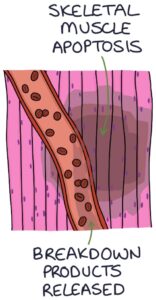Rhabdomyolysis involves skeletal muscle breaking down and releasing various chemicals into the blood. Muscle cells (myocytes) undergo cell death (apoptosis), releasing:
- Myoglobin
- Potassium
- Phosphate
- Creatine kinase

Potassium is the most immediately dangerous breakdown product. Hyperkalaemia can cause cardiac arrhythmias and cardiac arrest.
These breakdown products can cause acute kidney injury. Myoglobin, in particular, is toxic in high concentrations. Impaired renal function results in further accumulation of these substances in the blood.
Other complications include compartment syndrome and disseminated intravascular coagulation.
Causes
Anything that causes significant damage to muscle cells can cause rhabdomyolysis. For example:
- Prolonged immobility, particularly frail patients who fall and spend time on the floor before being found
- Extremely rigorous exercise beyond the person’s fitness level (e.g., endurance events or CrossFit)
- Crush injuries
- Seizures
- Statins
Signs and Symptoms
- Muscle pain
- Muscle weakness
- Muscle swelling
- Reduced urine output (oliguria)
- Red-brown urine (myoglobinuria)
- Fatigue
- Nausea and vomiting
- Confusion (particularly in frail patients)
Investigations
Creatine kinase (CK) is the crucial diagnostic blood test for rhabdomyolysis. It is normally less than around 150 U/L. In rhabdomyolysis, it can be 1,000-100,000 U/L. It typically rises in the first 12 hours, then remains elevated for 1-3 days, then gradually falls. The higher the CK, the greater the risk of kidney injury.
Myoglobinuria refers to myoglobin in the urine. It gives urine a red-brown colour. A urine dipstick will be positive for blood.
Urea and electrolytes (U&E) are required for acute kidney injury and hyperkalaemia.
ECGs are used to assess and monitor the heart’s response to hyperkalaemia.
Management
Intravenous fluids are the mainstay of treatment to correct hypovolaemia and encourage filtration of the breakdown products. Treatment of complications, particularly hyperkalaemia, is also essential.
Additional options that are debatable and have associated risks include:
- Intravenous sodium bicarbonate (to increase urinary pH and reduce the toxic effects of myoglobinuria)
- Intravenous mannitol (to increase urine output and reduce oedema)
Last updated September 2023
Now, head over to members.zerotofinals.com and test your knowledge of this content. Testing yourself helps identify what you missed and strengthens your understanding and retention.

